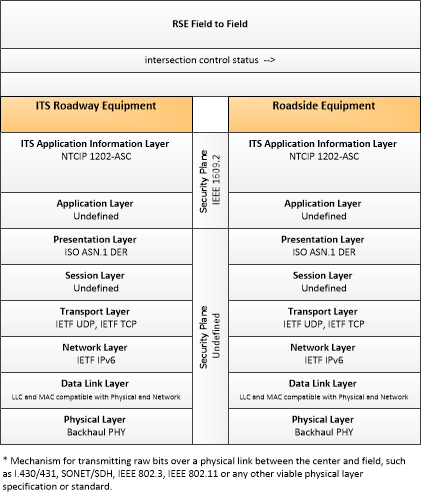Link Type: Field to Field
ITS Roadway Equipment --> Roadside Equipment:
intersection control status
Definitions
intersection control status (Information Flow): Status data provided by the traffic signal controller including phase information, alarm status, and priority/preempt status.
ITS Roadway Equipment (Source Physical Object): 'ITS Roadway Equipment' represents the ITS equipment that is distributed on and along the roadway that monitors and controls traffic and monitors and manages the roadway itself. In CVRIA, this physical object represents all of the other ITS field equipment that interfaces with and supports the Connected Vehicle Roadside Equipment (RSE). This physical object includes traffic detectors, environmental sensors, traffic signals, highway advisory radios, dynamic message signs, CCTV cameras and video image processing systems, grade crossing warning systems, and ramp metering systems. Lane management systems and barrier systems that control access to transportation infrastructure such as roadways, bridges and tunnels are also included. This object also provides environmental monitoring including sensors that measure road conditions, surface weather, and vehicle emissions. Work zone systems including work zone surveillance, traffic control, driver warning, and work crew safety systems are also included.
Roadside Equipment (Destination Physical Object): 'Roadside Equipment' (RSE) represents the Connected Vehicle roadside devices that are used to send messages to, and receive messages from, nearby vehicles using Dedicated Short Range Communications (DSRC) or other alternative wireless communications technologies. Communications with adjacent field equipment and back office centers that monitor and control the RSE are also supported. This device operates from a fixed position and may be permanently deployed or a portable device that is located temporarily in the vicinity of a traffic incident, road construction, or a special event. It includes a processor, data storage, and communications capabilities that support secure communications with passing vehicles, other field equipment, and centers.
Included In
This Information Flow is in the following Applications:
- Eco-Approach and Departure at Signalized Intersections
- Eco-Transit Signal Priority
- Emergency Vehicle Preemption
- Freight Signal Priority
- Intelligent Traffic Signal System
- Pedestrian in Signalized Crosswalk Warning
- Pedestrian Mobility
- Red Light Violation Warning
- Transit Signal Priority
This Information Flow is in the following Application Objects:
Communication Diagrams
The communication diagram(s) can be viewed in SVG or PNG format and the current format is SVG. Switch to PNG format.
Characteristics
Architectural:
| Characteristic | Value |
|---|---|
| Time Context | Recent |
| Spatial Context | Adjacent |
| Acknowledgement | False |
| Cardinality | Unicast |
| Initiator | Destination |
Security
This information flow triple is in the following applications with the following security levels.
| Information Flow Security | |||||
|---|---|---|---|---|---|
| Application | Confidentiality | Integrity | Availability | ||
| Basis | Basis | Basis | |||
| Emergency Vehicle Preemption | Low | Moderate | Moderate | ||
| This data is intentionally transmitted to everyone via a broadcast. It can also be determined via other visual indicators. | The vehicle will do more harm than an ordinary car if it runs the lights, and the driver may be under pressure to go fast in order to meet scheduled service, so the risk and impact of accidents from invalid messages might be slightly higher than for ordinary cars; however, the drivers are trained professionals and the vehicles are large and easy to spot, and will have lights and sirens, lowering the risk of accidents. Overall we do not see sufficient justification to raise the integrity requirement to HIGH. | Without this data, the RSE cannot broadcast it. However, this data is semi-predictable, so a few missed messages will not have a significant impact. Additionally, there are other indicators (such as the lights themselves) of the intersection status. | |||
| Pedestrian in Signalized Crosswalk Warning | Low | High | Moderate | ||
| This data is later intentionally transmitted to everyone via a broadcast. | If this is compromised, the Roadway Equipment and Roadside Equipment will be sending messages that are inconsistent with each other, leading to confusion and possible accidents and reducing the ability of the application to provide value. If this information is incorrect, it could lead to a collision between a vehicle and a pedestrian. | If this is down, the RSE doesn't get the information it needs to stay in synch with the actual signal state, reducing or eliminating the value add from having this application. The RSE must detect a lack of availability and choose not to send out-of-date information, so a failure of availability cannot have worse consequences than a failure of integrity which we have previously assessed at MEDIUM. | |||
| Transit Signal Priority | Low | Moderate | Moderate | ||
| This data is intentionally transmitted to everyone via a broadcast. It can also be determined via other visual indicators. | The vehicle will do more harm than an ordinary car if it runs the lights, and the driver may be under pressure to go fast in order to meet scheduled service, so the risk and impact of accidents from invalid messages might be slightly higher than for ordinary cars; however, the drivers are trained professionals and the vehicles are large and easy to spot, lowering the risk of accidents. Overall we do not see sufficient justification to raise the integrity requirement to HIGH. | Without this data, the RSE cannot broadcast it. However, this data is semi-predictable, so a few missed messages will not have a significant impact. Additionally, there are other indicators (such as the lights themselves) of the intersection status. | |||
